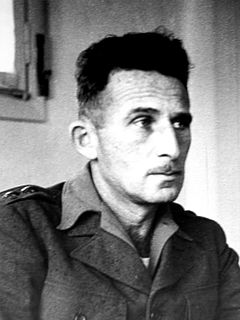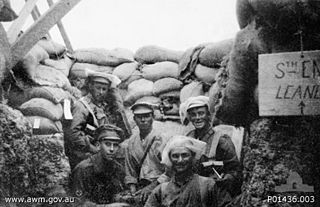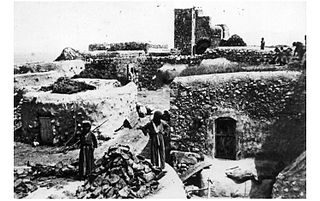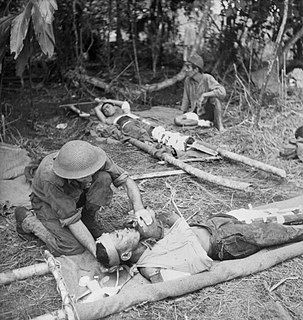Related Research Articles

Shimon Avidan, born Siegbert Koch, was an Israeli soldier and officer, the commander of the Givati Brigade during the 1948 Arab-Israeli war.

The Eucumbene River, a perennial river of the Snowy River catchment, is located in the Snowy Mountains region of New South Wales, Australia.

The 2/1st Battalion was an infantry battalion of the Australian Army. Formed as part of the Second Australian Imperial Force at the start of World War II, the battalion was deployed to the Middle East in early 1940 and subsequently took part in the early fighting in the North African campaign, taking part in battles around Bardia and Tobruk before later being sent to Greece in early 1941. A lightning German advance quickly pushed the Allies back and forced them to evacuate after a very short campaign and the 2/1st was landed on Crete where they subsequently fought unsuccessfully to repel a German invasion in May. The majority of the battalion was captured on Crete, but the 2/1st was subsequently re-built from survivors in Palestine and returned to Australia in early 1942 following Japan's entry into the war. They then fought two campaigns against the Japanese in New Guinea, fighting in the Kokoda Track campaign during 1942–43 and the Aitape–Wewak campaign in 1944–45. Following the war, the 2/1st was disbanded.

The 2/2nd Battalion was an infantry battalion of the Australian Army raised for service as part of the all-volunteer Second Australian Imperial Force during World War II. Raised in October 1939, the battalion was deployed to the Middle East and in early 1941 took part in the first ground action undertaken by Australian troops during the war during the Battle of Bardia before helping to capture Tobruk. In April, the battalion briefly fought in Greece, before being evacuated after the Allied forces were overwhelmed by German forces. Some members of the battalion took part in the Battle of Crete, after which the battalion undertook garrison duties in Syria. In mid-1942, the 2/2nd undertook defensive duties in Ceylon before returning to Australia. They subsequently took part in the fighting against the Japanese along the Kokoda Track and then around Buna–Gona. After a period of reorganisation and training in Australia throughout 1943–44, late in the war the battalion was committed to the Aitape–Wewak campaign before being disbanded in early 1946 after the war.

The 12th Battalion was an infantry battalion originally raised for the First Australian Imperial Force during the First World War. The battalion was recruited from Tasmania, South Australia and Western Australia and formed part of the 3rd Brigade, 1st Division. It served throughout the war, firstly during the Gallipoli Campaign and then on the Western Front. During the interwar years, the 12th Battalion was re-raised as a part-time military unit and during the Second World War undertook garrison duties in Australia, but did not see combat. Today its lineage is perpetuated by the 12th/40th Battalion, Royal Tasmania Regiment, a unit which continues to serve in the Australian Army Reserve.

The 179th Fighter Squadron is a unit of the Minnesota Air National Guard 148th Fighter Wing located at Duluth Air National Guard Base, Minnesota. The 179th is equipped with the General Dynamics F-16C Fighting Falcon.
Pongani is a village on the north coast of Papua New Guinea in Dyke Ackland Bay, Oro Province.

Approximately three million German prisoners of war were captured by the Soviet Union during World War II, most of them during the great advances of the Red Army in the last year of the war. The POWs were employed as forced labor in the Soviet wartime economy and post-war reconstruction. By 1950 almost all surviving POWs had been released, with the last prisoner returning from the USSR in 1956. According to Soviet records 381,067 German Wehrmacht POWs died in NKVD camps.

The Japanese destroyer Kamikaze was the lead ship of nine Kamikaze-class destroyers built for the Imperial Japanese Navy (IJN) during the 1920s. At the beginning of the Pacific War in December 1941, the ship was assigned to the Ōminato Guard District. She remained in northern Japanese waters until mid-1942 when she participated in the Aleutian Islands Campaign. Kamikaze continued to patrol northern Japanese waters until early 1945 when she was transferred to the Singapore area.
Soputa is a village located inland from Gona, Buna and Sanananda in Oro province, Papua New Guinea. The village is located at the crossroads of the Kokoda-Sananada Road and Buna-Kokoda Road. Trails lead to Buna and Sananada.
Gona is a coastal village in Oro Province, Papua New Guinea.
The 2/7th Cavalry (Commando) Regiment was one of three commando regiments raised by the Australian Army for service during World War II. It was originally raised as the 7th Division Cavalry Regiment in 1940 and in this guise it served in North Africa and the Middle East at the beginning of the war, before it was brought back to Australia and sent to New Guinea in late 1942 to serve against the Japanese. In mid-1943 the Australian high command decided to disband the divisional cavalry regiments and use their headquarters elements to administer the independent companies that had been raised earlier in the war. In the process the 7th Division Cavalry Regiment disbanded its squadrons, gave up their vehicles and changed its name to the 2/7th Cavalry (Commando) Regiment, as it became the administrative headquarters for the 2/3rd, 2/5th and 2/6th Commando Squadrons.

Hulayqat was a Palestinian Arab village in the Gaza Subdistrict. It was depopulated during the 1947–1948 Civil War in Mandatory Palestine. It was located 20.5 km northeast of Gaza.

The 55th/53rd Battalion was an infantry battalion of the Australian Army which saw active service during World War II. First formed in 1919 during the demobilisation of the Australian Imperial Force, the battalion was an amalgamation of two other units, the 55th and 53rd Battalions. It was disbanded shortly afterwards and remained off the order of battle until 1937 when it was raised as a part-time unit of the Militia, based in Sydney. In 1941, with the expansion of the Australian Army in response to the growing threat of war in the Pacific, the battalion was split and the 55th and 53rd Battalions reformed separately. In late 1942, however, they were amalgamated once more and together went on to participate in the fighting against the Japanese in New Guinea and on Bougainville.
Itacajá is a municipality in the state of Tocantins in the Northern region of Brazil.
Sonoli is a village in Belgaum district of Karnataka, India.

The Battle of Buna–Gona was part of the New Guinea campaign in the Pacific Theatre during World War II. It followed the conclusion of the Kokoda Track campaign and lasted from 16 November 1942 until 22 January 1943. The battle was fought by Australian and United States forces against the Japanese beachheads at Buna, Sanananda and Gona. From these, the Japanese had launched an overland attack on Port Moresby. In light of developments in the Solomon Islands campaign, Japanese forces approaching Port Moresby were ordered to withdraw to and secure these bases on the northern coast. Australian forces maintained contact as the Japanese conducted a well-ordered rearguard action. The Allied objective was to eject the Japanese forces from these positions and deny them their further use. The Japanese forces were skillful, well prepared and resolute in their defence. They had developed a strong network of well-concealed defences.
Operation Opossum was a World War II raid undertaken by Australia's Z Special Unit in 1945 on the island of Ternate near Borneo to rescue the Sultan of Ternate, Iskander Muhammad Jabit Syah.

The Battle of Buna–Gona was part of the New Guinea campaign in the Pacific Theatre during World War II. It followed the conclusion of the Kokoda Track campaign and lasted from 16 November 1942 until 22 January 1943. The battle was conducted by Australian and United States forces against the Japanese beachheads at Buna, Sanananda and Gona.
References
This article includes a list of references, related reading or external links, but its sources remain unclear because it lacks inline citations .(June 2016) (Learn how and when to remove this template message) |
Coordinates: 8°38′S148°22′E / 8.633°S 148.367°E